طاحونة مائية
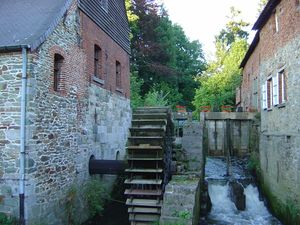
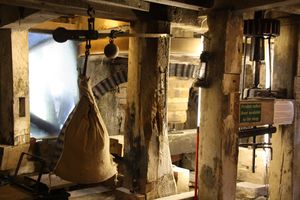
الطاحونة المائيةWatermill تبيّن تاريخياً أن منطقة حوض البحر المتوسط قد شهدت استخدام الطاحونة المائية في القرن الأول قبل الميلاد، وكان هناك نوعان من هذه الطواحين. ولا يزال النوع الأول قيد التشغيل حتى يومنا هذا في كل من إسكندنافيا والبلقان وبلدان الشرق الأدنى. وفيها يتم تركيب العجلة المائية أفقياً في أسفل الطاحونة بحيث يدور الطرف السفلي لمحورها الرأسي المصنوع من الحديد، داخل محمل من الحجارة الثقيلة (الصخرية منها). ويمر الطرف العلوي للمحور عبر فتحة في حجر الرحى السفلي ويتصل مباشرة بحجر الرحى العلوي، وبذلك تحتاج إلى مسننات لنقل الحركة. وتكون سرعة دوران حجر الرحى مماثلة لسرعة دوران العجلة المائية، وتدار الأخيرة بفعل الماء الهابط من علوّ من مجرى مياه جارية باستمرار.

ومنها اتخذ مبدأ العنفة الحديثة لتوليد الكهرباء من الماء. ويكون النوع الثاني من الطواحين المائية مماثلاً حيث يكون دفع الماء في الأعلى بدلاً من الأسفل. فشاع استخدام الطواحين المائية كثيراً في الوديان وقرب الأنهر فبلغت في أوروبا نحو 5624 طاحونة حوالي العام 1000م. ومع اختراع العجلة المائية والصناعات الحديثة ومن ثم المحركات تضاءل استخدام الطواحين المائية إذا لم نقل إنه قد انقرض.
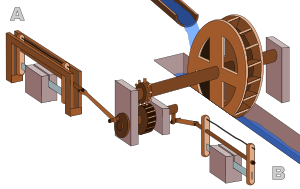
| First Appearance of Various Industrial Mills in Medieval Europe, AD 770-1443 [3] | |||||||||||
|---|---|---|---|---|---|---|---|---|---|---|---|
| Type of mill | Date | Country | |||||||||
| Malt mill | 770 | France | |||||||||
| Fulling mill | 1080 | France | |||||||||
| Tanning mill | ca. 1134 | France | |||||||||
| Forge mill | ca. 1200 | England, France | |||||||||
| Tool-sharpening mill | 1203 | France | |||||||||
| Hemp mill | 1209 | France | |||||||||
| Bellows | 1269, 1283 | Slovakia, France | |||||||||
| Paper mill[4] | 1282 | Spain | |||||||||
| Sawmill | ca. 1300 | France | |||||||||
| Ore-crushing mill | 1317 | Germany | |||||||||
| Blast furnace | 1384 | France | |||||||||
| Cutting and slitting mill | 1443 | France | |||||||||
. . . . . . . . . . . . . . . . . . . . . . . . . . . . . . . . . . . . . . . . . . . . . . . . . . . . . . . . . . . . . . . . . . . . . . . . . . . . . . . . . . . . . . . . . . . . . . . . . . . . . . . . . . . . . . . . . . . . . . . . . . . . . . . . . . . . . . . . . . . . . . . . . . . . . . . . . . . . . . . . . . . . . . . .
الصين القديمة

عملية لطاحونة مائية
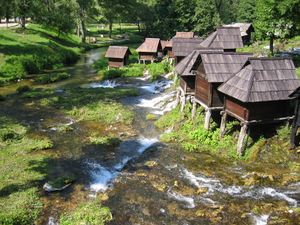
أنواع طواحين المائية
معرض الصور
انظر أيضا
- List of watermills
- Hydropower
- Micro hydro
- Millstone
- Molinology
- The International Molinological Society
- Renewable Energy
- Roman engineering
- Sustainable living
- Sutter's Mill
- Watermills in the United Kingdom
- Horse mill
- Claverton Pumping Station - a waterwheel-powered pumping station
- Watermill of Veaux
- Windmill
- List of watermills in France
ملاحظات
- ^ خطأ استشهاد: وسم
<ref>غير صحيح؛ لا نص تم توفيره للمراجع المسماةRitti, Grewe, Kessener 2007, 161 - ^ Wilson 1995, pp. 507f.; Wikander 2000, p. 377; Donners, Waelkens & Deckers 2002, p. 13
- ^ Adam Robert Lucas, 'Industrial Milling in the Ancient and Medieval Worlds. A Survey of the Evidence for an Industrial Revolution in Medieval Europe', Technology and Culture, Vol. 46, (Jan. 2005), pp. 1-30 (17).
- ^ Burns 1996, pp. 417f.
- ^ خطأ استشهاد: وسم
<ref>غير صحيح؛ لا نص تم توفيره للمراجع المسماةUndershot wheel mill - ^ خطأ استشهاد: وسم
<ref>غير صحيح؛ لا نص تم توفيره للمراجع المسماةOvershot wheel mill - ^ خطأ استشهاد: وسم
<ref>غير صحيح؛ لا نص تم توفيره للمراجع المسماةWikander 2000, 375
المصادر
- Burns, Robert I. (1996), "Paper comes to the West, 800−1400", in Lindgren, Uta, Europäische Technik im Mittelalter. 800 bis 1400. Tradition und Innovation (4th ed.), Berlin: Gebr. Mann Verlag, pp. 413–422, ISBN 3-7861-1748-9
- de Crespigny, Rafe. (2007). A Biographical Dictionary of Later Han to the Three Kingdoms (23-220 AD). Leiden: Koninklijke Brill. ISBN 90-04-15605-4.
- Donners, K.; Waelkens, M.; Deckers, J. (2002), "Water Mills in the Area of Sagalassos: A Disappearing Ancient Technology", Anatolian Studies (Anatolian Studies, Vol. 52) 52: 1–17, doi:, http://jstor.org/stable/3643076
- Gauldie, Enid (1981). The Scottish Miller 1700 - 1900. Pub. John Donald. ISBN 0-85976-067-7.
- Gimpel, Jean (1977), The Medieval Machine: The Industrial Revolution of the Middle Ages, London: Penguin (Non-Classics), ISBN 978-0140045147
- Holt, Richard (1988), The Mills of Medieval England, Oxford: Blackwell Publishers, ISBN 978-0631156925
- Langdon, John (2004), Mills in the Medieval Economy: England, 1300-1540, Oxford: Oxford University Press, ISBN 0199265585
- Lewis, M. J., Millstone and Hammer: the origins of water power, University of Hull Press 1997. ISBN 0-85958-657-X.
- McErlean, Thomas; Crothers, Norman (2007), Harnessing the Tides: The Early Medieval Tide Mills at Nendrum Monastery, Strangford Lough, Belfast: Stationery Office Books, ISBN 978-0-337-08877-3
- Murphy, Donald (2005), Excavations of a Mill at Killoteran, Co. Waterford as Part of the N-25 Waterford By-Pass Project, Estuarine/ Alluvial Archaeology in Ireland. Towards Best Practice, University College Dublin and National Roads Authority, http://www.acsltd.ie/cms/uploads/02_02_kiloteran_mill_-_ucd.pdf
- Needham, Joseph. (1986). Science and Civilisation in China: Volume 4, Physics and Physical Technology; Part 2, Mechanical Engineering. Taipei: Caves Books Ltd. ISBN 0-521-05803-1.
- Pacey, Arnold, Technology in World Civilization: A Thousand-year History, The MIT Press; Reprint edition (July 1, 1991). ISBN 0-262-66072-5.
- Reynolds, Terry S. Stronger Than a Hundred Men: A History of the Vertical Water Wheel. (Johns Hopkins University Press 1983). ISBN 0-8018-7248-0.
- Ritti, Tullia; Grewe, Klaus; Kessener, Paul (2007), "A Relief of a Water-powered Stone Saw Mill on a Sarcophagus at Hierapolis and its Implications", Journal of Roman Archaeology 20: 138–163
- Rynne, Colin (2000), "Waterpower in Medieval Ireland", in Squatriti, Paolo, Working with Water in Medieval Europe, Technology and Change in History, 3, Leiden: Brill, pp. 1–50, ISBN 90-04-10680-4
- Spain, Rob: "A possible Roman Tide Mill", Paper submitted to the Kent Archaeological Society
- Wikander, Örjan (1985), "Archaeological Evidence for Early Water-Mills. An Interim Report", History of Technology 10: 151–179
- Wikander, Örjan (2000), "The Water-Mill", in Wikander, Örjan, Handbook of Ancient Water Technology, Technology and Change in History, 2, Leiden: Brill, pp. 371–400, ISBN 90-04-11123-9
- Wilson, Andrew (1995), "Water-Power in North Africa and the Development of the Horizontal Water-Wheel", Journal of Roman Archaeology 8: 499–510
- Wilson, Andrew (2002), "Machines, Power and the Ancient Economy", The Journal of Roman Studies (The Journal of Roman Studies, Vol. 92) 92: 1–32, doi:, http://jstor.org/stable/3184857
. . . . . . . . . . . . . . . . . . . . . . . . . . . . . . . . . . . . . . . . . . . . . . . . . . . . . . . . . . . . . . . . . . . . . . . . . . . . . . . . . . . . . . . . . . . . . . . . . . . . . . . . . . . . . . . . . . . . . . . . . . . . . . . . . . . . . . . . . . . . . . . . . . . . . . . . . . . . . . . . . . . . . . . .
وصلات خارجية
- Video "The Power of Water - The Newlin Gristmill" produced by Nicholas Newlin Foundation
- 17 Jun 2003, Deutsche Welle: The World's First Underwater Windmill Starts Turning
- U.S. Mill Pictures and Information
- Tidal power station
- Mill database with over 10000 european mills
- Watermills in Norfolk, England
- Mills in Hampshire, England
- The International Molinological Society (TIMS)
- The Society for the Preservation of Old Mills (SPOOM)
- Tidal mill in London
- Watermills of the Dukes of Urbino
- Windmills & Watermills of the East Grinstead area
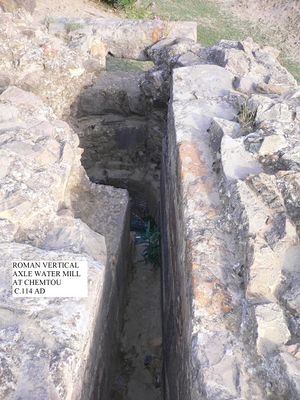

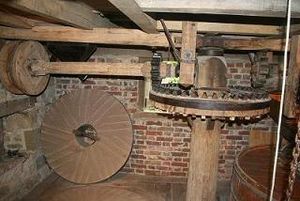
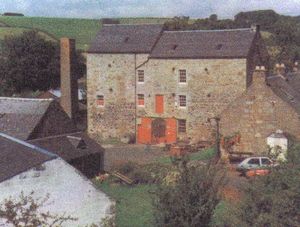
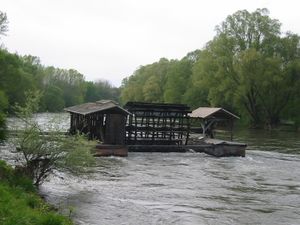
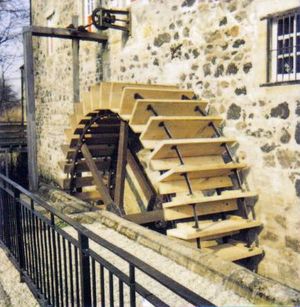
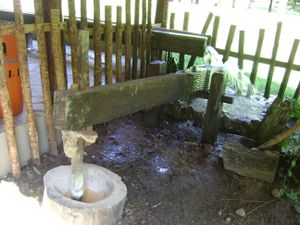
![Undershot water wheel, applied for watermilling since the 1st century BC[5]](/w/images/thumb/1/12/Undershot_water_wheel_schematic.svg/120px-Undershot_water_wheel_schematic.svg.png)
![Overshot water wheel, applied for watermilling since the 1st century BC[6]](/w/images/thumb/5/53/Overshot_water_wheel_schematic.svg/116px-Overshot_water_wheel_schematic.svg.png)
![Breastshot water wheel, applied for watermilling since the 3rd century AD[7]](/w/images/thumb/c/c9/Breastshot_water_wheel_schematic.png/116px-Breastshot_water_wheel_schematic.png)